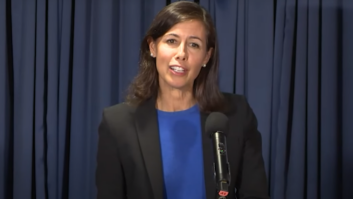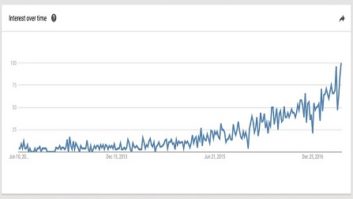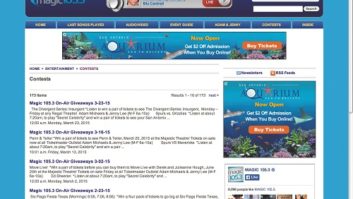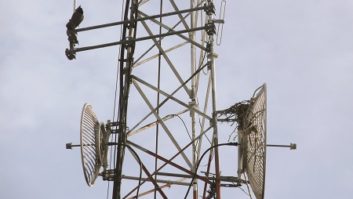Web Watch is a roundup of all things radio and the Web. Send your news and tips to Internet Radio editor Laura Dely via e-mail to LD@imaspub.com.
This Web Watcher is confused: Why does Internet radio appear to be stalled, while broadband access continues to grow and other online media metrics continue to report increased online listening? How can this be?
Check this
For example, according to the latest Internet radio study from Arbitron and Edison Media Research, although broadband access has been less widespread than originally projected, it continues to be a consumer catalyst for streaming media.
According to the study, released at The NAB Radio Show last month, 64 percent of those with broadband connections are at least monthly Internet radio users as opposed to just 43 percent of dial-up users.
“One (common) assumption about broadband access is that it increases media experience. Another 13 percent (of survey participants) plan to get broadband access in the next year, in addition to the 18 percent that already have broadband. That is a significant number,” said Bill Rose, Arbitron’s Webcast Services vice president and general manager.
Also, more than half of Americans online have at least tried audio or video streaming media, according to the Arbitron and Edison study. That 52 percent is up from 44 percent from the first of the year and amounts to some 78 million people.
This number may be similar to trying but not inhaling, as the study also shows only 12 percent of Internet usxers say they have listened to Internet-only audio channels and radio station Webcasts on a monthly basis.
And consider that the FCC, too, reports that broadband access has seen healthy growth. Its figures show that the number of high-speed connections grew 63 percent in the second half of last year.
Of the 7.1 million high-speed lines, 5.2 million were connections to homes and small businesses. About 4.3 million of those lines provided service at speeds over 200 kbps in both directions. The total number of DSL phone lines swelled to 2 million, compared with the 3.6 million cable-modem connections. (DSL uses traditional phone lines, while cable modems use cable-television lines.)
And the total time spent listening at the end of August had more than doubled since the first of the year, according to MeasureCast Inc. This increase came in spite of the fact the measurement occurred over a time when many workers are traditionally on vacation.
So why is Internet radio stuck?
Two-thirds of listeners reported that they were “very” or “somewhat” upset that radio stations they listen to online stopped streaming, according to the new Arbitron/Edison study.
Rose said there is a danger for terrestrial broadcasters in silencing their streams.
“Stations are at risk of losing these listeners to Net-only Webcasters who are available online despite legal and regulatory challenges facing them,” said Rose.
“Over half (55 percent) of all online listeners say they have found other sources of Internet audio to listen to in its place,” he said.
Listeners on the rise
Rose said the study found that, for the first time, Internet-only stations have equaled streaming radio stations in number of listeners.
“It appears that the head start that radio stations enjoyed in this arena has been lost,” Rose said.
The Arbitron and Edison study found strong consumer interest in subscription services to gain access to content that is only available online.
“There is another model out there,” Rose said. “There is a willingness to pay for unique and compelling streamed content, as there continues to be for cable pay channels and pay-per-view. Broadcasters should consider a mix of ad-supported and subscription-based revenue,” Rose said.
Topping the list of kinds of content that Net-radio users would pay for are concerts and performances by favorite artists, followed by sports events. Rose pointed to the success of this summer’s Major League Baseball subscription deal with RealNetworks Inc., providing audio streams of MLB games for a fee, as an example.
In September, some terrestrial broadcasters began to stream again, including Clear Channel’s KIIS(FM) in Los Angeles and New Wave Broadcasting’s KPIG(FM) in Santa Cruz, Calif.
KIIS was the first Clear Channel station to go back to Webcasting, but the company said it would soon follow with many others. With a new partnership with the ad-insertion company Hiwire, the media giant appears ready to comply with AFTRA’s triple-rate online fees by using only non-union, local talent and music beds in place of national inventory.
On the ratings front, 45 stations appeared in both the July and August ratings from MeasureCast. Of those same stations, 8.5 percent streamed more hours in August than in the previous month.
But the comparable Internet-only stations streamed 1 percent fewer hours in August than they did in July, while the comparable terrestrial stations streamed 30.5 percent more hours in August than they did in July. (There are still many more Internet-only stations in the top-50 ratings since the AFTRA move in April.)
MEDIAmazing.com once again took the No. 1 spot in the MeasureCast ratings, which it has held for the past six months. MEDIAmazing is a listener-formatted, Internet-only Webcaster that allows its listeners to chose their formats.
In Arbitron’s latest Webcast ratings, for March 2001, Launch.com’s Launch Media joined the pack in the No. 7 position. NetRadio.com’s NetRadio remained in first place, with more than four million aggregate tuning hours. The company has maintained its leading position since Arbitron began reporting network ratings in October of last year.
Live365.com held fast in the No. 2 spot with more than 3.5 million ATH, a number that has doubled in the four months since the December 2000 network ratings report. ABC Radio Networks ranked No. 3 with more than 2.1 million ATH.
Arbitron defines Webcast networks as radio station owners who stream their content online or companies that aggregate online audio programming.
Total Internet traffic growth exceeds that in previous years, according to a study done by Dr. Larry Roberts, CTO at Caspian Networks. (Caspian designs and builds Internet and network infrastructure equipment.)
With figures supplied by 19 U.S. Internet service providers, he found Web traffic increased by a factor of 3.75 times this year.
Conclusions
Among his conclusions, he predicts that increased demand will mean carriers will no longer be operating with a surplus of ports. He said they will rapidly approach the point where their networks will begin to show blocking of traffic unless more infrastructure is built.
Roberts’ scenario reminds this Web Watcher of what happened when AOL began to offer unlimited access in early 1997. For months to follow, AOL dialups more often than not resulted in a busy signal.
Audio advertising via Internet streaming increased brand awareness in a study done by Lightningcast and Diameter, the research division of DoubleClick Inc. The Web ads, done for a major cellular carrier whose identity the companies said is confidential, showed an ad awareness increase of 64 percent and an ad tagline recall increase of 60 percent.
The study compared brand awareness of the cellular carrier’s audio ad among a randomly sampled target group of 560 Web users on Internet radio, where roughly half of the study’s participants were exposed to a 6-second audio ad while the rest formed the control group that did not.
“For some time, brand marketers have been wondering when and if the Web would satisfy their requirements as an advertising medium. This case study indicates that their wait is over,” said Karl Spangenberg, Lightningcast president and CEO.
DiscJockey.com, a Webcaster that provided live and on-demand channels on a range of topics and music genres, has ceased operation and is in Chapter 7 bankruptcy in the United States Bankruptcy Court for the District of Massachusetts, Boston Division.
The company’s URL directs Web visitors to Swiggart & Agin LLC, a law firm that handles bankruptcies and insolvencies.
DiscJockey.com revised its business model last September when it introduced a subscription-based, commercial-free “Gold” service.
That was followed less than a month later by a 50-percent staff reduction.
Domain names DiscJockey.com, Disc JockeyGold.com and DiscJockeyPlus.com were put up for sale.
Mobile Internet radio lost an enabler when Metricom, a wireless Internet access company, shut down their network in August. This followed a Chapter 11 bankruptcy filing for the company that offered wireless access of up to 128k in 15 cities in the United States. Metricom stranded more than 40,000 users and left a billion dollars in debt.
Live365, whose wireless MP3 player system was capable of using either Metricom’s modem or mobile phones, said the Metricom system was far and away the fastest connection. According to Live365’s Alan Wallace, the loss of Metricom represents a hiccup in their plans, but that the company is still distributing Metricom’s software via download on the Live365 Website.
Hope
He said the G 2.5 and G 3 cell phone services offer additional promise for wireless Internet radio. (Live365 is also hopeful someone will revive Metricom.)
Live365 had big news at The NAB Radio Show: It added IP-based Geo-targeting to its services. Advertisers and broadcasters will be able to insert local ads into their global streams that will target listeners wherever they are.
“We have always said that buyers should look at advertising on Live365 as they would as local radio campaign,” said Paul Adams, Live365’s vice president, advertising sales. “Thanks to geo-targeting, we can not only deliver advertising by market, but also provide the advertiser with the reports that deliver real results.”
SiteShell Corp., which offers services that help radio stations keep their Web sites up to date, confirms that it is in discussions with other companies regarding topics ranging from outright acquisition to indirect support for a major financing, which would keep the company independent.
The company has 165 live local radio station Web sites and about 250 affiliated stations.
No.1 needs help
NetRadio may be the top Webcaster by Arbitron’s count, but the company has signed on a new president and CEO: turnaround specialist Cary L. Deacon.
Deacon succeeds Eric Paulson, who has served as interim CEO. Paulson will remain as chairman.
Prior to joining NetRadio, Deacon served as president and COO of SkyMall, the struggling in-flight and e-commerce retailer he prepped for sale this summer to Gemstar-TV Guide International.
He has a 26-year background in cable and retail marketing.
To allow listeners access to NetRadio channels away from a PC, the company also announced an agreement with OpenGlobe, which specializes in bringing Internet radio to entertainment devices other than personal computers.
Mobile
“Our agreement with OpenGlobe is a another significant step towards extending the delivery of NetRadio’s content beyond the reach of the PC by allowing listeners to access it in their homes, while shopping in malls, retail stores, in corporate private networks and eventually in the car and on portable devices,” said Steve Holderman, executive vice president of marketing and sales, NetRadio.
Through this agreement with OpenGlobe, NetRadio’s channels will be streamed on the Compaq iPAQ Music Center, Kenwood Sovereign Entre and others yet to be announced. (OpenGlobe announced a similar partnership with Radio Free Virgin two months earlier.)
AccuWeather.com teamed with Yahoo! to introduce “Shoot the Breeze,” a weekly, interactive talk show that focuses on different weather-related topics. According to the companies, weather is the No. 1 topic on the Internet.
The program will feature AccuWeather’s expert meteorologists for live feedback during the show, which is Webcast at 7 p.m. EST Thursdays from www.accuweather.com.
FM stations that are still shopping for tools to begin streaming their signals may be interested in BRS Media’s“My Radio.FM.”
According to George T. Bundy, chairman and CEO, the service provides a “.FM” Web address, Web hosting that includes e-mail and a customized version of AllCast’s streaming broadcast software called the “AllCast Broadcaster.”
Bundy said the AllCast streaming software considerably reduces bandwidth costs for broadcasters as it employs a “peer-to-multi-peer” technique.
“With this method, users distribute the content to each other rather than receiving it all from one central place and so it reduces bandwidth requirement and with it the cost of Webcasting,” Bundy said.
The fee for the My Radio.FM starts at $19.95 per month, according to Bundy.
iBEAM, a streaming services provider, received a $30 million investment from Williams Communications in addition to $10 million from unnamed investors. Williams, a broadband content distributor, will own 49 percent of the company.
Now iBEAM will have access to Williams’ growing fiber optic network.
Loudeye Technologies Inc., launched its “Loudeye Radio” service at The NAB Radio Show. The company, which holds licensing agreements with the five major music labels as well as approximately 800 independent labels, will now offer custom programming based on that authorized content, “personalities” to host programs, geographically-targeted ad insertion and verification, a national sales team, syndication services and a customized radio player.
“Loudeye Radio represents what we believe to be the next generation of Internet radio and signifies the first time the industry has realized a complete Internet radio solution from one company,” said Joel McConaughy, Loudeye’s chief technology officer.
Fingerprinting
The Radio Show launch followed Loudeye’s announcement that it will provide song identification and metadata for Napster’s upcoming file sharing service. Loudeye will generate digital signatures, or fingerprints, for Napster’s songs.
The service is necessary to allow Napster to identify songs that must be filtered out, as ruled by a court decision earlier this year. This requirement has been a continued challenge for Napster.
It’s Loudeye’s music label-authorized catalog that enables this deal. It seems that the company, which has made several strategic Internet radio acquisitions in the past five months, is making a play to own the Internet radio arena.
This is going to be hard to believe, but those additional windows called pop-up screens that open while viewing some Internet pages are annoying, according to psychologist Susan Weinschenk, Ph.D.
“In our lab, we see users closing pop-up screens as quickly as possible, even before the pop-ups finish loading,” said Weinschenk, who heads Weinschenk Consulting Group.
“They’re definitely annoyed – and annoyed people leave a site sooner and are less likely to return. Furthermore, the pop-up screen distracts them from their task, said Weinschenk. “They might have been trying to purchase something.”
She warns that people who feel pestered at a Web site transfer their annoyance to the company that appears responsible.
“Consequently, pop-up screens are not a plus for your image,” Weinschenk.







